في عالم مثالي، سيبدأ كل مشروع ويبقى وينتهي في الموعد المحدد وكما هو مخطط له تمامًا. كان جميع أعضاء فريقك سيكملون مهامهم وتسليماتهم قبل الموعد المحدد.
ستبقى الميزانية كما هي طوال فترة المشروع. سيكون أصحاب المصلحة راضين تمامًا عن جودة عملك.
يمكننا أن نحلم بالتأكيد، ولكن في الواقع، لا يوجد مشروع مثالي. التخطيط السليم يساعد فريقك على تجنب المشاكل الشائعة إدارة المشروع الانتكاسات مثل المواعيد النهائية الفائتة والطلبات غير المتوقعة لعمل إضافي.
قلل من هذه العقبات من خلال تحديد نطاق المشروع قبل البدء في أي عمل. فمع وضع توقعات واضحة ومساءلة واضحة، يكون لديك والعميل أساس متين لبدء المشروع ومنع حدوث أي زحف في النطاق.
يرشدك هذا الدليل إلى كيفية بناء بيان قوي لنطاق المشروع ويوفر بعضًا من أفضل الموارد للبدء! دليلنا قوالب إدارة المشروع والكل في واحد أدوات الإنتاجية ستساعدك على تعزيز كيفية إدارتك لنطاق المشروع وتنفيذه.
هل أنت مستعد؟ /%img/ https://clickup.com/blog/wp-content/uploads/2022/07/ClickUp-Goals-Feature-CTA-V4.png ClickUp Goals ميزة الأهداف CTA المدونة /%img/
ما هو نطاق المشروع؟
نطاق المشروع هو بيان موثق لـ كل شيء يدخل في إنجاح المشروع. ويحدد النطاق الكامل نطاق العمل ومتطلبات المشروع، مع توضيح ما يتضمنه وما لا يتضمنه.
يتم تسجيل جميع هذه المواصفات وتخزينها في بيان نطاق المشروع. وببساطة، فإن بيان النطاق يقيّم و الخطوط العريضة للمشروع بالكامل قبل أن يبدأ أي شخص العمل. فهو يوفر تفصيلاً مفصلاً لجميع الأعمال التي سيقوم بها فريق المشروع ويحدد التوقعات حول كيفية وموعد إنجاز هذا العمل.
وثيقة النطاق بمثابة مخطط المشروع. إنها خطوة مهمة في إدارة المشروع لأنه يجمع كل المعلومات المهمة التي يجب أن يعرفها أصحاب المصلحة الرئيسيين.
تتضمن وثيقة نطاق المشروع عادةً ما يلي:
- أهداف المشروع :: نظرة عامة رفيعة المستوى لأهداف مشروعك
- أصحاب المصلحة في المشروع : الأشخاص المشاركون في المشروع
- الموارد المخصصة : مثل أعضاء الفريق، والميزانيات، والتكنولوجيا
- قيود المشروع: قيود الوقت والأشخاص والتكاليف التي يجب أن تعمل ضمنها
- الجدول الزمني : الأطر الزمنية التي يجب عليك إكمال كل جزء من المشروع ضمنها
- التسليمات *: النتائج الملموسة لمشروعك المكتمل
- الاستثناءات: ما لن يتضمنه مشروعك، ويعرف أيضاً باسم العمل خارج النطاق
فوائد تحديد نطاق المشروع ## فوائد تحديد نطاق المشروع
بدون نطاق مشروع محدد بوضوح، يمكن أن يضيع فريقك بسهولة. يحمي نطاق مشروعك فريقك من فشل المشروع ويجعلك تتقدم نحو أهدافك النهائية.
فيما يلي بعض الأسباب الرئيسية التي تجعل تحديد نطاق المشروع قبل البدء في أي عمل مفيدًا لفريقك:
- تجنبزحف النطاق: منع العمل من التوسع خارج حدوده من خلال توضيح ما هو مدرج وما هو غير مدرج بالضبط. حدّد حدود المشروع، وامنع فريقك من التوسّع المفرط أو الإرهاق.
- ضع مبادئ توجيهية للتغييرات: لا أحد يحب التغييراتمتطلبات المشروعولكن هذا يحدث. ضع عمليات حول كيفية تغيير النطاق بطريقة لا تؤثر بشكل كبير وغير متوقع على فريقك.
- إبقاء المشاريع على المسار الصحيح: واضحالجداول الزمنية للمشروع تخلق المساءلة وتحافظ على سير مشاريعك. كما أنها تحدد طرقًا لقياس تقدم فريقك نحو تحقيق الأهداف من خلال المواعيد النهائية والمعالم الرئيسية والتسليمات.
- إدارة التوقعات: اجعل فريقك وعملائك وأصحاب المصلحة على نفس الصفحة حتى يعرف الجميع المسؤوليات والنتائج المتوقعة وتواريخ الاستحقاق الحرجة.
- تقليل المخاطر: استمع وراقب عوامل الخطر المحتملة مثل تجاوز الميزانية أو التأخر عن الجدول الزمني. التوعية ضرورية لتوقع فشل المشروع وتجنبها بسهولة.
كيفية كتابة بيان نطاق المشروع في 7 خطوات
أي فجوة صغيرة في نطاق مشروعك تترك مساحة كافية لانحراف المشروع عن مساره. لهذا السبب فإن وثيقة نطاق المشروع يجب أن تغطي جميع المعلمات التي يجب أن يعرفها أصحاب المصلحة حول المشروع.
إليك كيفية كتابة بيان شامل وواضح لنطاق المشروع في سبع خطوات بسيطة:
1. حدد أصحاب المصلحة
اجعل الجميع على نفس الصفحة من خلال الحصول على موافقة على النطاق من الجميع أصحاب المصلحة في المشروع -كل شخص لديه رأي في كيفية سير مشروعك. هذه هي أفضل عملية لإدارة المشروع للتأكد من أن بيان النطاق الخاص بك واقعي وقابل للتحقيق.
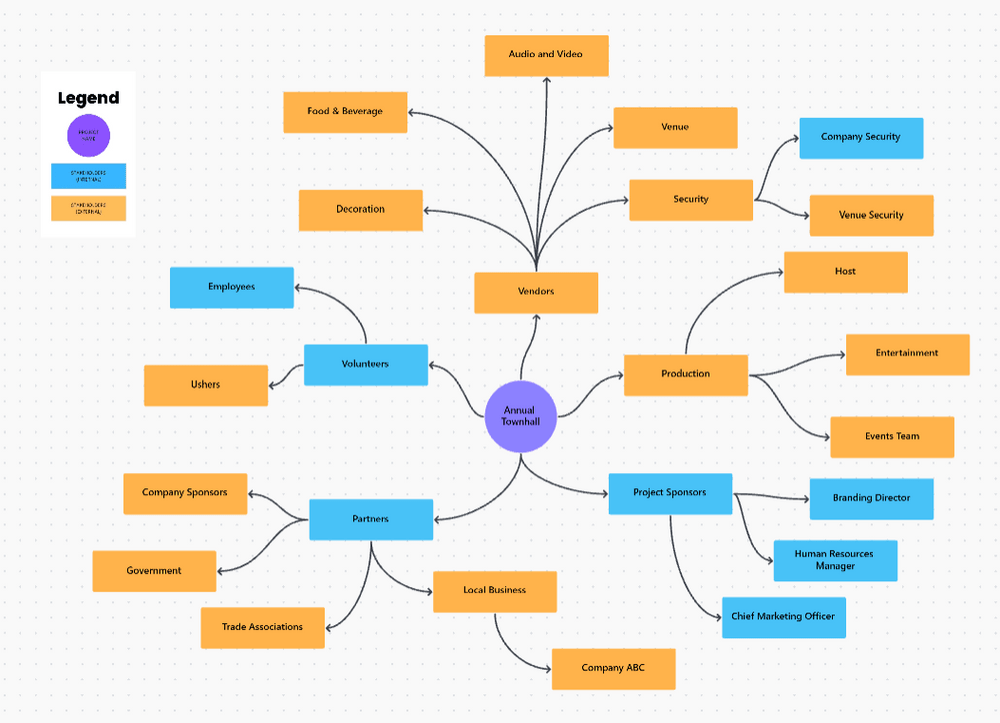
استخدم ميزة اللوحة البيضاء في ClickUp لتحديد أهم أصحاب المصلحة في مشروعك باستخدام هذا القالب البسيط المُعد مسبقًا
قم بإنشاء خريطة أصحاب المصلحة لسرد جميع الأشخاص المهمين المشاركين في المشروع لإعطاء نفسك فكرة عن الأشخاص الذين يمكنهم مساعدتك في السباق نحو نجاح المشروع. لحسن الحظ قالب خريطة أصحاب المصلحة في ClickUp الذي يجعل تعيين أصحاب المصلحة والتخطيط سهل التنظيم!
تنزيل نموذج خريطة أصحاب المصلحة
حدد جميع أصحاب المصلحة الذين يتخذون القرارات التي تؤثر على مشروعك، بما في ذلك:
- أصحاب المصلحة الداخليين: أعضاء الفريق ومديرو المشروع والمدراء التنفيذيون
- أصحاب المصلحة الخارجيين: العملاء والعملاء أو المستخدمون والبائعون والمستثمرون
أشرك أصحاب المصلحة هؤلاء خلال تحديد نطاق المشروع، بحيث يكون الجميع على دراية بما يمكن توقعه من المشروع وكيف يمكنهم المساهمة في نجاحه. احصل على ملاحظاتهم وطرح الأفكار وإعادة صياغة الأهداف حسب الضرورة.
2. حدد بوضوح أهداف المشروع الأساسية لعميلك
قد تبدأ كلمة "مشروع" بحرف "P"، ولكن كل مشروع يبدأ في الواقع بـ "لماذا" 😏
توضيح مشروعك الأهداف يجب أن تكون الخطوة الأولى في تحديد نطاق المشروع لأنها تشرح لماذا العمل ضروري.
بمجرد أن تفهم لماذا يسعى العميل إلى هذا المشروع، ستعرف أنت وفريقك ما الذي سيركز عليه العميل عند تقييمه لعملك. صمم مخرجاتك بناءً على هذه الأهداف، وهناك فرصة جيدة لأن يكون العميل سعيدًا.
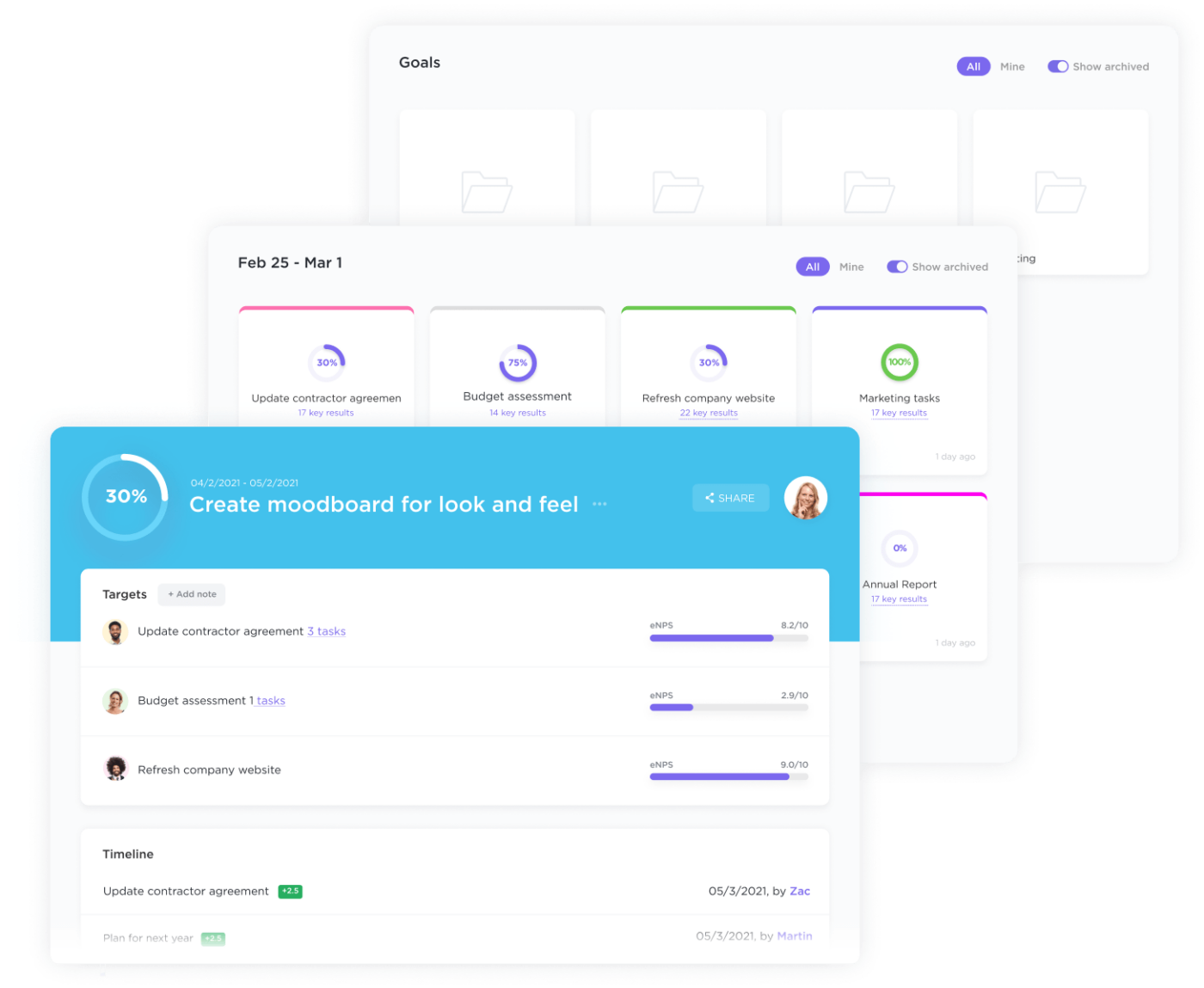
ابقَ على المسار الصحيح لتحقيق أهدافك من خلال جداول زمنية واضحة وأهداف قابلة للقياس وتتبع التقدم التلقائي
تشكل أهداف المشروع أيضًا دورك كمستشار استراتيجي. وبالإضافة إلى الإنجازات الملموسة، يمكنك أيضًا تقديم نصائح حول كيفية تحقيق العملاء لأهدافهم لكسبهم.
اطرح على نفسك هذه الأسئلة للمساعدة في تحديد أهدافك:
- ما هي النتائج التي تأمل في تحقيقها؟
- كيف ستحققنجاح المشروع سيتم قياسه؟
- هل هناكمقاييس أو مؤشرات أداء رئيسية لتتبع الأداء المعياري؟
بمجرد تحديد أهدافك المحددة، استخدمها لمساعدة فريقك على إنشاء عمل عالي الجودة ضمن النطاق. قد يحاول العملاء - خاصة العملاء الجدد أو الذين يصعب إرضاؤهم - إلقاء المهام في طريقك أو تقديم اقتراحات لا تتعلق بالهدف الأكبر للمشروع. ربما يتلكأون في إيصال الملاحظات إليك في الوقت المحدد.
ذكّر العميل بأهدافك عندما تظهر المشاكل (وربما حتى قبل ذلك). من الجيد دائمًا أن تُظهر كيف تعمل التسليمات والمهام - إذا تم إنجازها في مواعيدها المحددة - على تحقيق تلك الأهداف!
وإذا لزم الأمر، قم برفض اقتراحات العميل في اللحظة الأخيرة التي لا تتماشى مع نجم الشمال من خلال توضيح كيف يمكن للتغييرات المقترحة أن تغير بالضبط من الجدول الزمني للمشروع .
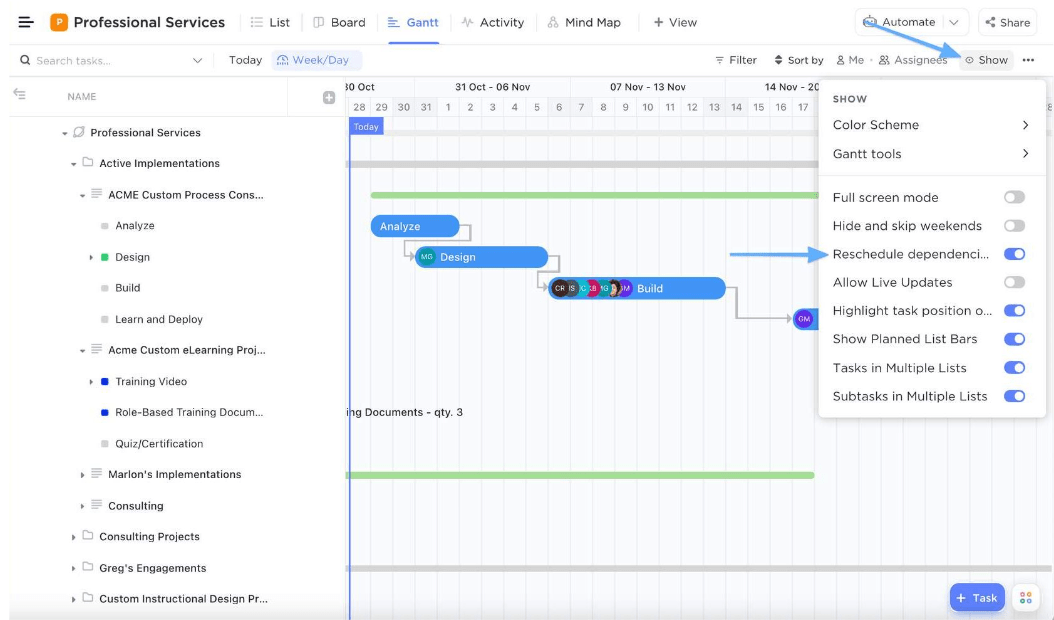
إعادة جدولة التبعيات لتصور تأثير تغييرات تاريخ الاستحقاق على المهام داخل عرض جانت في ClickUp
من خلال إظهار تأثير التغييرات الصغيرة أو الرئيسية في المشروع للعميل على وجه التحديد، فإنك تعطي نظرة غير متحيزة لما يحدثه ذلك على سير العمل. ونحن نفهم ذلك - بعض العملاء صعب الإرضاء.
لحسن الحظ، لست مضطرًا للرضوخ للطلبات العشوائية أو طلبات اللحظة الأخيرة من خلال إظهار تأثير الطلبات بوضوح وأفضل مسار لإبقاء المشاريع ضمن النطاق وعلى المسار الصحيح.
عند كتابة أهداف مشروعك، حافظ على الأهداف الذكية إطار العمل في الاعتبار. حدد الأهداف التي تكون:
- مممحددة
- مقابلة للتحقيق
- أيمكن تحقيقها
- صمذات صلة بالموضوع
- تممحددة زمنياً
سيضمن ذلك أن يكون نطاق المشروع واقعيًا مع وضع معايير لتقييم نجاحه.
3. تخصيص الموارد لتقليل الإرهاق إلى أدنى حد ممكن وزيادة الأرباح
لا يمكنك تحديد ما سيعمل عليه فريقك حتى تعرف الموارد المتاحة. وما لم تكن تلعب Minecraft في الوضع الإبداعي، فلن يكون لديك موارد لا نهائية.
فكل شركة محدودة بحجم فرقها وميزانيتها وتقنياتها.
يتضمن نطاق المشروع تخصيص الموارد للتأكد من أن مشروعك يحتوي على عدد كافٍ من أعضاء الفريق ، وجميع التقنيات اللازمة والميزانية المناسبة المخصصة له لتحقيق النجاح. يعد تخصيص الموارد أمرًا ضروريًا لتخطيط كيفية عمل فريقك بالضبط كيف سيحقق فريقك النجاح إكمال مشاريعك .
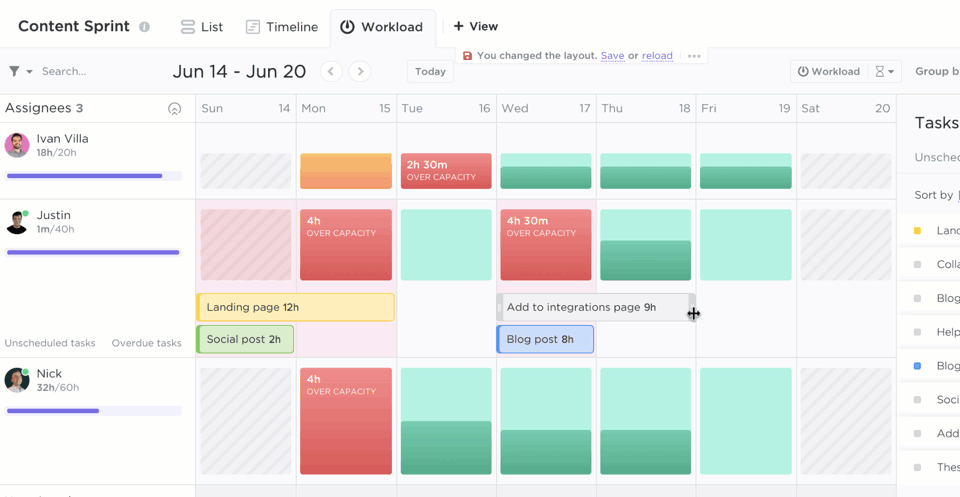
استخدم طريقة عرض عبء العمل في ClickUp لمعرفة من هو متقدم أو متأخر وسحب المهام وإفلاتها بسهولة لإعادة تخصيص الموارد
بالنسبة لمديري المشروعات وقادة الفرق، من الضروري استخدام إدارة عبء العمل أدوات حتى لا يقضي أعضاء الفريق ساعات طويلة جدًا على عميل معين. من المفيد أيضًا أن يكون لديك عرض عبء العمل التي يمكن أن تمنع أحد الموظفين من العمل أكثر أو أقل من موظف آخر.
علاوة:_% قوالب تخطيط الموارد يمكن أن تكون مواردك عدة أشياء مختلفة أيضاً. تتضمن بعض الموارد الأكثر شيوعاً ما يلي:
- أعضاء الفريق: إجمالي عدد أعضاء فريقك، والمسؤوليات الموكلة لكل عضو، وعدد الساعات اللازمة أسبوعيًا لكل مهمة
- التقنية: ما هي المعدات والبرامج والأدوات التي تحتاجها لإكمال هذا المشروع
- ميزانية المشروع: ميزانيات العميل أو ميزانيات المشروع الداخلية أو القيود أو المجمعات المتاحة
عليك أن تعمل بما لديك - والقليل من التخطيط يقطع شوطاً طويلاً! إن معرفة الموارد المتاحة لديك يسهل عليك العمل ضمن هذه الإرشادات.
تحقق من هذه قوالب ميثاق الفريق/%href/_ !
4. حدد المخرجات الدقيقة التي يحتاجها عملاؤك
الآن بعد أن عرفت ما هي الموارد المتاحة لك، أنت الآن جاهز لتحديد ما الذي سينتج المشروع لعملائك: المخرجات. يجب أن تحدد وثيقة نطاق مشروعك بوضوح مخرجات المشروع بحيث تعرف وكالتك وعملائها ما سيتم إنشاؤه بالضبط.
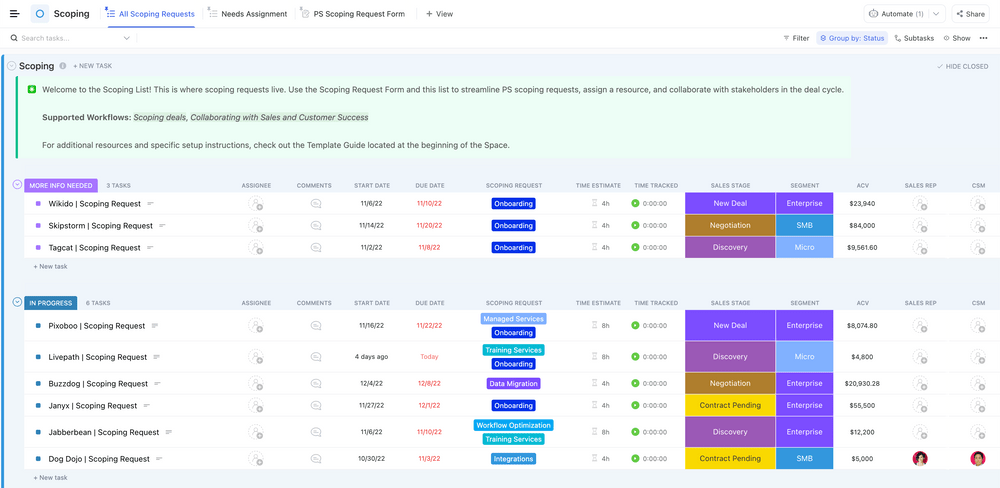
تعاون بثقة مع العملاء واجعلهم سعداء مع هذا القالب الفريد للخدمات المهنية
ارجع إلى أهداف مشروعك عندما تقوم بتحديد أهداف مشروعك عند تحديد مخرجاتك. هل تحتاج إلى مساعدة في تنظيمها؟ استخدم نموذج ClickUp للخدمات الاحترافية لسرعة تتبع عملية تأهيل العميل عند تحديد ما يجب تسليمه بالضبط.
تنزيل نموذج الخدمات الاحترافية
يجب أن تكون نواتجك بمثابة نقطة انطلاق نحو تحقيق الهدف الأسمى لمشروعك وإرضاء متطلبات المشروع . ما هي النتائج القابلة للقياس التي سيحققها مشروعك عند اكتماله؟
يمكن أن تكون المخرجات المحددة ملموسة أو غير ملموسة لفريق المشروع. يمكن أن تعني إدارة نطاق المشروع الكثير من الأشياء المختلفة لمختلف الوكالات، ولكن بعض الأمثلة الشائعة على المخرجات تشمل:
- منشورات المدونات ودراسات الحالة والأوراق البيضاء
- التقارير
- الاستشارات
- التدقيق
- ميزة جديدة أوالمنتج
- برنامج تدريبي لتعليم الموظفين كيفية استخدام برنامج جديد
5. تحديد أي وجميع قيود المشروع
إذن أنت تعرف ما هو مشروعك، ولكن ماذا عن ما هو _لا ؟ وماذا عن عوامل الخطر التي قد تتسبب في فشل مشروعك؟ من الخطوات المهمة - ولكن غالبًا ما يتم تجاهلها - في صياغة النطاق تحديد قيود المشروع واستثناءاته.
القيود هي عوامل تحد من مشروعك، مثل:
- الحدود الزمنية وتواريخ الاستحقاق والمواعيد النهائية
- تكاليف الأجزاء المختلفة من المشروع مقابل ميزانية المشروع المخصصة
- زحف النطاق والتغييرات على نطاق العمل المتفق عليه مسبقاً
الاستثناءات هي المهام المستثناة هي المهام التي _ليست جزءاً من المشروع! ما هي المهام التي لا تريد القيام بها على وجه التحديد أو لا تستطيع القيام بها؟

استخدم الوقت في الحالة لتحديد أي اختناقات وتلقي إشعار ذي صلة تلقائيًا في ClickUp
على سبيل المثال، قد تحدد مثلاً أن فريق التسويق عبر وسائل التواصل الاجتماعي لديك لن يكون مسؤولاً عن جدولة المنشورات التي ينشئها. من خلال الاستغناء عن الوقت الذي كان سيقضيه في إدارة وسائل التواصل الاجتماعي ، يمكن لفريقك التركيز على مجالات خبرتهم: الاستراتيجية وإنشاء المحتوى.
إن معرفة ما لن تركز عليه سيجعلك تركز على ما هو أكثر أهمية! وهذا يعني أن بإمكانك تحديد أولوياتك في تحديد المنجزات التي ستساعد عميلك على تحقيق أهداف مشروعه.
مع هذه الحدود، لا تحتاج أنت وأعضاء فريقك إلى القيام بكل ما يطلبه العميل. يمكنك أن تقرر كوكالة كيفية توزيع وقتك وطاقتك على عملاء محددين. خصص مواردك بفعالية أكبر، بدلاً من محاولة بذل الكثير من الجهد والمخاطرة بالإفراط في العمل (والإرهاق).
وضع حدود متينة لمديري مشروعك أو أعضاء فريقك، وهذا بدوره سيؤهلهم للنجاح! موظفون أكثر سعادة، وعملاء أكثر سعادة - وفرصة أقل لـ فشل المشروع !
6. قم بإنشاء جدول زمني شامل ومحدث دائمًا للمشروع
إذا كانت نواتج المشروع هي "ماذا" المشروع، فإن الجدول الزمني لمشروعك هو "متى" يجب أن يتضمن نطاق مشروعك تفصيلاً زمنيًا للأحداث والمهام التي ينطوي عليها مشروعك.
وهذا ينشئ المعالم التي يجب على فريقك الوصول إليها في مواعيد نهائية محددة من أجل إحراز تقدم نحو أهدافك. لا يلزم أن يحتوي بيان نطاق مشروعك على جدول زمني مفصل يومًا بيوم لكل مهمة صغيرة. ومع ذلك، يجب أن يتضمن
- تواريخ البدء والانتهاء للمشروع
- قائمة بالمهام الرئيسية المتضمنة في مشروعك
- تواريخ استحقاق تلك المهام
- مقدار الوقت اللازم لإكمال كل مهمة
- تبعيات المهام التي قد تعيق المعالم المذكورة أعلاه
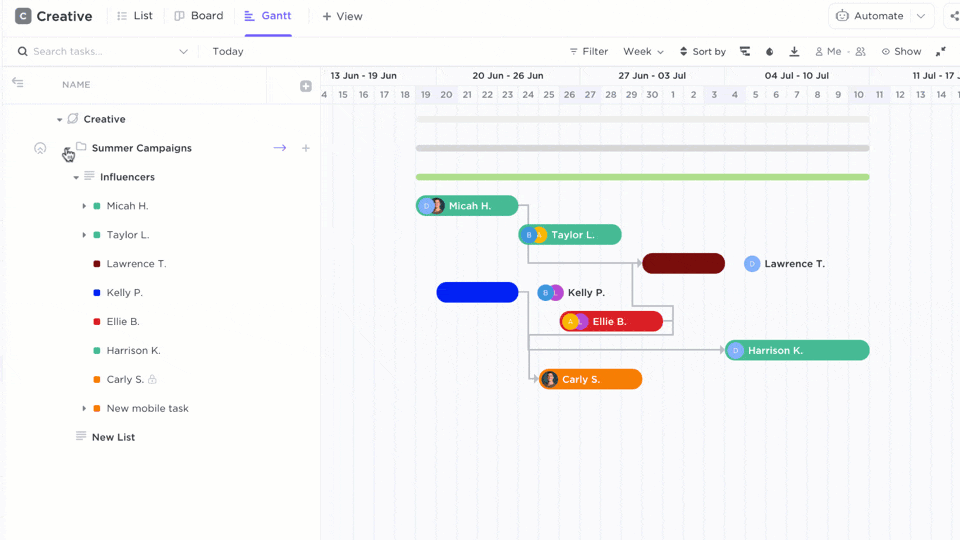
إظهار المزيد من العناصر مثل المكلفين وتواريخ الاستحقاق والمزيد في الشريط الجانبي لعرض جانت
يساعد الجدول الزمني لمشروعك فريقك على تصور الصورة الكبيرة لمشروعك وكيفية تأثير مكوناته على بعضها البعض. فهو يبقي فريقك على المسار الصحيح ويمنح رؤية واضحة لأي اختناقات.
7. ضع عملية إدارة نطاق يمكن التحكم فيها وواقعية
أنت تعرف ما يقولون - غالبًا ما تنحرف أفضل الخطط الموضوعة من الفئران والرجال عن مسارها. وعلى الرغم من خطة المشروع الممتازة فإن مشروعك سيغير مسار مشروعك على طول الطريق.
حتى أفضل فرق إدارة نطاق المشروع ستكون عرضة للتغييرات بسبب عوامل مثل تخفيضات الميزانية, دوران الموظفين والمتطلبات الإضافية. بينما يجب أن يمنع بيان نطاق المشروع الخاص بك العمل خارج النطاق، إلا أنه في بعض الأحيان، يكون تغيير النطاق أمرًا لا مفر منه.
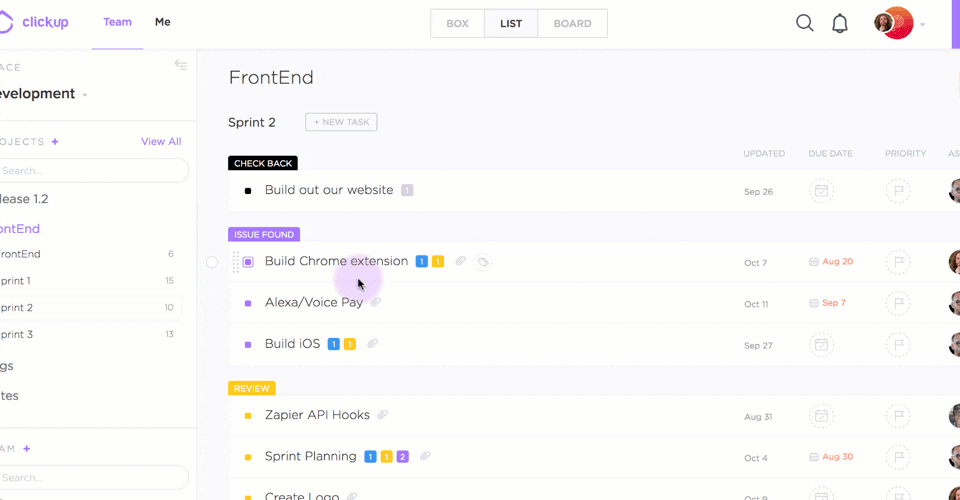
استخدم ميزة إدارة المهام المتعددة في ClickUp عندما تحتاج إلى إجراء عدة تغييرات في المشروع في وقت واحد
إليك كيف يمكنك إعداد خطة إدارة نطاق المشروع التي يمكن أن تساعدك على التحكم في زحف النطاق:
- تعيين القيود عدد المرات التي ستقوم فيها بتغيير أشياء معينة
- تعيين أعضاء الفريق: تعيين نقاط الاتصال لتنسيق التغييرات
- وضع العمليات: وضع العمليات: تأكد من أن طلبات التغيير تخضع لموافقة جميع أصحاب المصلحة المعنيين
- ضع ميزانية للوقت والموارد : الاستعداد لجولات متعددة من التغييرات
أخيرًا، بعد أن تتاح الفرصة للجميع لمراجعة بيان النطاق، احصل على توقيع جميع أصحاب المصلحة على بيان النطاق الخاص بك. تأكد من أن كل شخص لديه نسخة للرجوع إليها بعد بدء المشروع .
بالإضافة إلى ذلك، يمكنك اعتماد منهجية إدارة المشروع مثل رشيقة أو سكروم وكلاهما مصمم للتعامل مع أي تغيير مفاجئ في النطاق!
ذات صلة:_%
_/مرجع/ /مدونة؟ p=46493 كيفية كتابة مقترح مشروع *%/%href/_
مثال على بيان نطاق المشروع أثناء العمل
أنتِ جين، مديرة في وكالة تسويق، وقد تم تكليفك بمهمة إدارة حملة تسويق المحتوى ل Sugar-O's، حبوب الإفطار الجديدة التي يوشك عميلك على إطلاقها. حلوة!
أول ما عليك فعله هو تحديد نطاق مشروعك. يمكن أن يبدو مثال نطاق مشروعك على النحو التالي:
أهداف المشروع
زيادة الوعي بالعلامة التجارية لـ Sugar-O's من خلال إنشاء مقالات تسويقية بالمحتوى تسلط الضوء على قيمتها، أي فوائدها الصحية ومذاقها اللذيذ الذي يحبه الأطفال والكبار على حد سواء.
أصحاب المصلحة في المشروع
سيساعد تحديد نطاق عمل الفريق بأكمله على عملية تخطيط المشروع . بالتأكيد متطلبات المشروع لأصحاب المصلحة، وحاول أن تدرج الجميع على هذا النحو:
| الاسم | الدور | المسؤوليات |
|---|---|---|
| جاين | مديرة المشروع | الحفاظ على نطاق المشروع على المسار الصحيح |
| سوزان | مديرة نجاح العملاء | التواصل مع العملاء بشأن متطلبات المشروع |
| ماري | مديرة تسويق المحتوى | البحث وكتابة المدونات |
| جيري | نائب الرئيس للتسويق | الموافقة على نطاق المشروع وتقديم الملاحظات بشأنه |
| راي | أخصائي تحسين محركات البحث | البحث عن الكلمات الرئيسية ذات القيمة العالية وكتابة الملخصات وتقديم الملاحظات |
الموارد المخصصة
- مسؤول إدارة علاقات العملاء، 30 ساعة عمل أسبوعيًا لمدة أربعة أسابيع
- مدبّر مواقع إلكتروني واحد، خمس ساعات عمل في الأسبوع لمدة أربعة أسابيع
- رئيس وزراء واحد، ساعتين من العمل في الأسبوع لمدة أربعة أسابيع
- محرر واحد، خمس ساعات عمل في الأسبوع لمدة أربعة أسابيع
- محرر نسخ واحد، خمس ساعات عمل أسبوعياً لمدة أربع أسابيع
- الميزانية: 10,000 دولار
المنجزات
- أربع (4) مقالات جاهزة للنشر لتسويق المحتوى المحسّن لتحسين محركات البحث (1,500-3,000 كلمة لكل منها)
القيود ### القيود
- يجب تقديم ملاحظات العميل في غضون أسبوع واحد من التسليم
- جدول عطلات العميل إذا كان المراجعون خارج المكتب
الجدول الزمني
- تاريخ بدء المشروع 1 أكتوبر
- تقوم سوزان بترتيب مكالمة انطلاق المشروع في 1 أكتوبر
- يسلم راي ملخصات تحسين محركات البحث للوكالة بحلول 14 أكتوبر
- تسلّم ماري المقال الأول بحلول 21 أكتوبر
- ملاحظات العميل على المقالة الأولى بحلول 28 أكتوبر
- تسليم المراجعات النهائية بحلول 1 نوفمبر
- تسلّم ماري المقالة الثانية بحلول 28 أكتوبر
- ملاحظات العميل على المقالة الثانية بحلول 4 نوفمبر
- تسليم المراجعات النهائية بحلول 7 نوفمبر
- تسلّم ماري المقالة الثالثة بحلول 4 نوفمبر
- ملاحظات العميل على المقالة الثالثة بحلول 11 نوفمبر
- تسليم المراجعات النهائية بحلول 14 نوفمبر
- تسلّم ماري المقالة الرابعة بحلول 11 نوفمبر
- ملاحظات العميل على المقالة الرابعة بحلول 18 نوفمبر
- تسليم المراجعات النهائية بحلول 21 نوفمبر
- تنشر شوغر أوز جميع المقالات بحلول 30 نوفمبر
الاستثناءات
- لا يوجد تصميم جرافيك
- لا يوجد أكثر من جولة واحدة من المراجعات لكل مقالة
ذات صلة:_
_/مرجع/ /مدونة؟ ص=4616846 مثلث إدارة المشاريع *%/href/_
قوالب إضافية لنطاق المشروع لتبدأ بها
كتابة وثيقة نطاق المشروع ليس بالأمر السهل، ولكن ليس عليك أن تبدأ من الصفر. اطلع على قوالب نطاق المشروع لمساعدتك في توحيد تخطيط مشروعك في أسرع وقت ممكن
انقر فوق نموذج نطاق العمل

جرب نموذج نطاق العمل الخاص ب ClickUp لتوثيق النواتج وتواريخ الاستحقاق والمراحل الرئيسية والمزيد
هل تحتاج إلى إنشاء وثيقة نطاق المشروع بسرعة؟ نموذج نطاق العمل الخاص ب ClickUp على القيام بذلك من خلال توفير مساحة لتوضيح العناصر الرئيسية:
- نظرة عامة على المشروع وأهدافه
- قائمة المهام
- معالم المشروع
- اجتماعات المشروع
- تقرير حالة المشروع
- الموافقة على المشروع
باستخدام هذا القالب، يمكنك تقسيم مشروعك إلى مهام أصغر حجماً وقابلة للتحقيق. يحدد هذا المستند التوقعات من خلال بناء جدول زمني يحدد المساءلة عن مخرجات مشروعك.
كما يتضمن أيضًا مساحة لأصحاب المصلحة للتوقيع على نطاق المشروع، بحيث يعرف الجميع أن العمل الموضح في المستند قد تم الاطلاع عليه والموافقة عليه.
تنزيل نموذج نطاق العمل
قالب السبورة البيضاء لنطاق المشروع ### قالب ClickUp نطاق المشروع
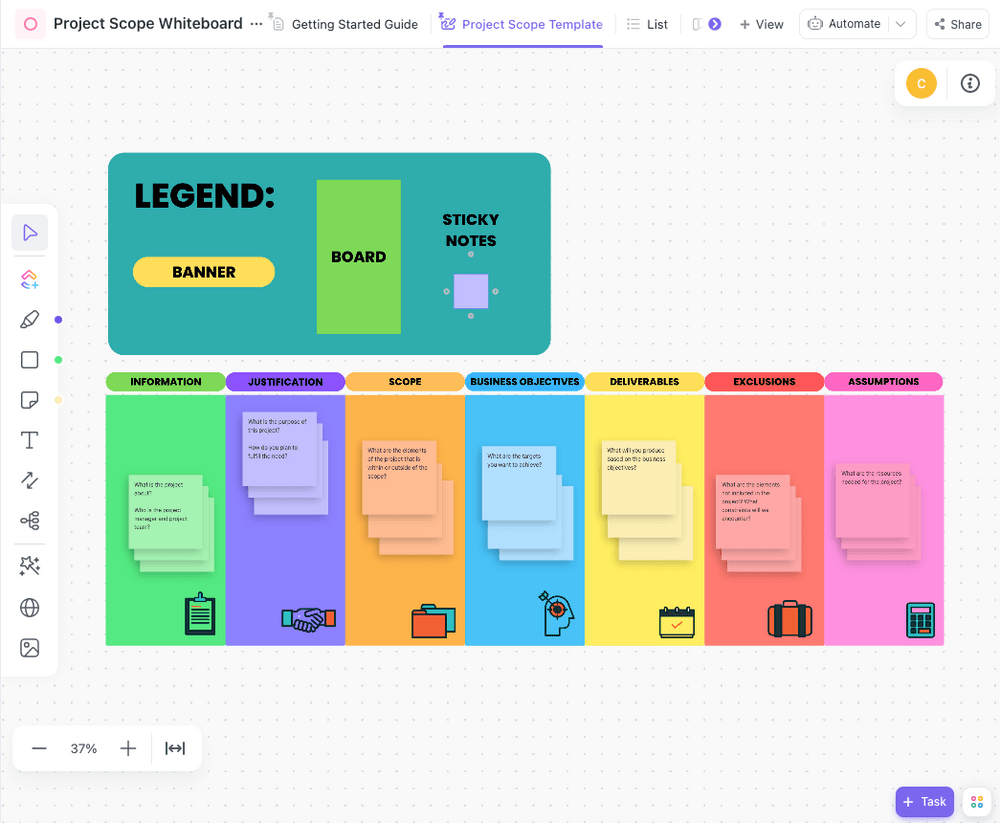
ضع بصريًا مسارًا واضحًا لنجاح المشروع بدءًا من البداية وحتى التسليم
من الذي لا يحب اللون الملون؟ هذا قالب نطاق المشروع ينظم جميع مكونات مشروعك المهمة على لوحة بيضاء مشرقة ونظيفة.
يمكنك بسهولة تحديد التفاصيل التي تحتاج إلى معرفتها مع تصور العناصر التي لا تزال بحاجة إلى مزيد من المعلومات. قم بتحديد نطاق مشروعك بالكامل: قم بإنشاء أهداف عملك، وحدد المخرجات، وسجل استثناءات وافتراضات المشروع.
قم بتدوين المعلومات عن طريق إضافة ملاحظات لاصقة، ثم اسحبها بين الأعمدة وفي جميع أنحاء السبورة بأي طريقة منطقية بالنسبة لك. قالب السبورة البيضاء لنطاق المشروع من ClickUp يفرز المعلومات في الأعمدة التالية:
- معلومات حول ماهية المشروع والغرض الرئيسي منه
- تبرير عن سبب أهمية المشروع
- نطاق ما هي المهام التي ينبغي أو لا ينبغي إدراجها في المشروع
- أهداف العمل التي تحدد الأهداف
- المخرجات، أي ما هي المخرجات التي سيتم إنتاجها
- الاستثناءات، العمل خارج نطاق المشروع
- الافتراضات، أو قائمة بالموارد اللازمة للمشروع
اجعل هذه الأعمدة خاصة بك! يمكنك إضافة أعمدة جديدة وإزالة الأعمدة الموجودة وتغييرها لتناسب احتياجاتك! هذا القالب قابل للتخصيص بالكامل ليناسب سير عملك.
قم بتنزيل قالب السبورة لنطاق المشروع
إدارة نطاق المشروع والمزيد في ClickUp
تُعد صياغة بيان نطاق مشروعك إحدى الخطوات الأولى في إدارة المشروع. فبمجرد حصولك على المخطط، عليك أن تقوم فعليًا ببناء وإنجاز وتسليم
يحتاج كل فريق عمل ناجح إلى الأداة المناسبة لمساعدته في هذه العملية، ولا يوجد برنامج إدارة المشاريع أفضل من ClickUp في الواقع ClickUp هو موقع أداة رائدة في إدارة المشاريع ! لديها جميع الميزات التي تحتاجها لتنفيذ مشروع أحلامك! إليك الطريقة:
- قسّم مشروعك إلىعناصر العمل مع المهام والمهام الفرعية وقوائم المراجعة
- وثّق كل شيء بنص غني باستخداممستندات ClickUpبما في ذلكميثاق المشروعونطاق المشروع ومتطلباته
- البقاء على اطلاع على ما يعمل عليه الجميع وإدارة الموارد باستخدام Box View وPulse
- التواصل مع أصحاب المصلحة وتعيين التعليقات عبر الدردشة
- تحديد أولويات العمل وتأكد من إكمال المهام دائمًا بالترتيب الصحيح باستخدام الأولويات والتبعيات
- احصل على نظرة شاملة للمشروع بأكمله باستخدام لوحات المعلومات
مع ClickUp، نوفر لك تغطية كاملة لدورة حياة المشروع بأكملها، بدءًا من نطاق المشروع وحتى التسليم النهائي. جرّب ClickUp مجانًا اليوم!

